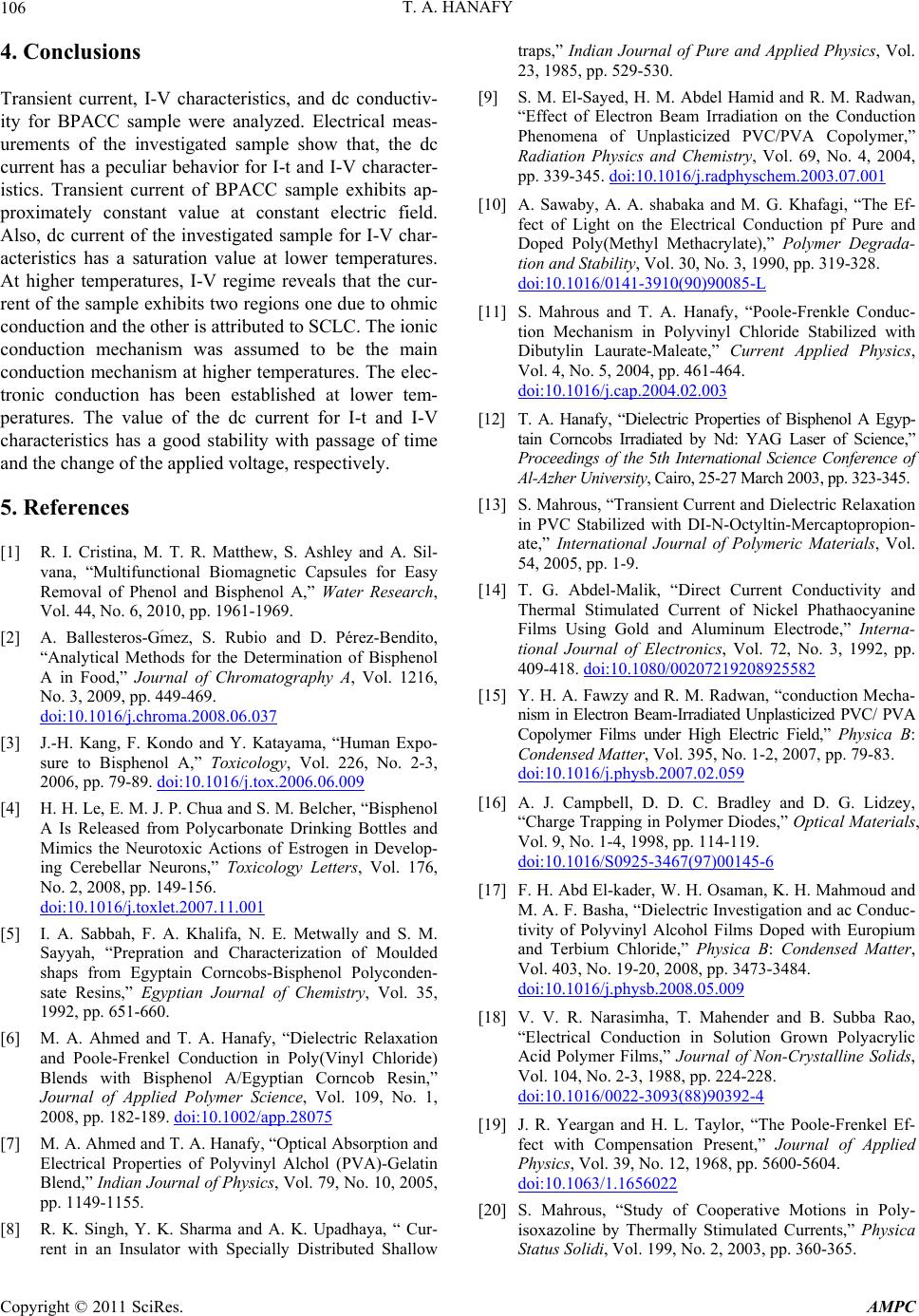
T. A. HANAFY
106
4. Conclusions
Transient current, I-V characteristics, and dc conductiv-
ity for BPACC sample were analyzed. Electrical meas-
urements of the investigated sample show that, the dc
current has a peculiar behavior for I-t and I-V character-
istics. Transient current of BPACC sample exhibits ap-
proximately constant value at constant electric field.
Also, dc current of the investigated sample for I-V char-
acteristics has a saturation value at lower temperatures.
At higher temperatures, I-V regime reveals that the cur-
rent of the sample exhibits two regions one due to ohmic
conduction and the other is attributed to SCLC. The ionic
conduction mechanism was assumed to be the main
conduction mechanism at higher temperatures. The elec-
tronic conduction has been established at lower tem-
peratures. The value of the dc current for I-t and I-V
characteristics has a good stability with passage of time
and the change of the applied voltage, respectively.
5. References
[1] R. I. Cristina, M. T. R. Matthew, S. Ashley and A. Sil-
vana, “Multifunctional Biomagnetic Capsules for Easy
Removal of Phenol and Bisphenol A,” Water Research,
Vol. 44, No. 6, 2010, pp. 1961-1969.
[2] A. Ballesteros-Gَmez, S. Rubio and D. Pérez-Bendito,
“Analytical Methods for the Determination of Bisphenol
A in Food,” Journal of Chromatography A, Vol. 1216,
No. 3, 2009, pp. 449-469.
doi:10.1016/j.chroma.2008.06.037
[3] J.-H. Kang, F. Kondo and Y. Katayama, “Human Expo-
sure to Bisphenol A,” Toxicology, Vol. 226, No. 2-3,
2006, pp. 79-89. doi:10.1016/j.tox.2006.06.009
[4] H. H. Le, E. M. J. P. Chua and S. M. Belcher, “Bisphenol
A Is Released from Polycarbonate Drinking Bottles and
Mimics the Neurotoxic Actions of Estrogen in Develop-
ing Cerebellar Neurons,” Toxicology Letters, Vol. 176,
No. 2, 2008, pp. 149-156.
doi:10.1016/j.toxlet.2007.11.001
[5] I. A. Sabbah, F. A. Khalifa, N. E. Metwally and S. M.
Sayyah, “Prepration and Characterization of Moulded
shaps from Egyptain Corncobs-Bisphenol Polyconden-
sate Resins,” Egyptian Journal of Chemistry, Vol. 35,
1992, pp. 651-660.
[6] M. A. Ahmed and T. A. Hanafy, “Dielectric Relaxation
and Poole-Frenkel Conduction in Poly(Vinyl Chloride)
Blends with Bisphenol A/Egyptian Corncob Resin,”
Journal of Applied Polymer Science, Vol. 109, No. 1,
2008, pp. 182-189. doi:10.1002/app.28075
[7] M. A. Ahmed and T. A. Hanafy, “Optical Absorption and
Electrical Properties of Polyvinyl Alchol (PVA)-Gelatin
Blend,” Indian Journal of Physics, Vol. 79, No. 10, 2005,
pp. 1149-1155.
[8] R. K. Singh, Y. K. Sharma and A. K. Upadhaya, “ Cur-
rent in an Insulator with Specially Distributed Shallow
traps,” Indian Journal of Pure and Applied Physics, Vol.
23, 1985, pp. 529-530.
[9] S. M. El-Sayed, H. M. Abdel Hamid and R. M. Radwan,
“Effect of Electron Beam Irradiation on the Conduction
Phenomena of Unplasticized PVC/PVA Copolymer,”
Radiation Physics and Chemistry, Vol. 69, No. 4, 2004,
pp. 339-345. doi:10.1016/j.radphyschem.2003.07.001
[10] A. Sawaby, A. A. shabaka and M. G. Khafagi, “The Ef-
fect of Light on the Electrical Conduction pf Pure and
Doped Poly(Methyl Methacrylate),” Polymer Degrada-
tion and Stability, Vol. 30, No. 3, 1990, pp. 319-328.
doi:10.1016/0141-3910(90)90085-L
[11] S. Mahrous and T. A. Hanafy, “Poole-Frenkle Conduc-
tion Mechanism in Polyvinyl Chloride Stabilized with
Dibutylin Laurate-Maleate,” Current Applied Physics,
Vol. 4, No. 5, 2004, pp. 461-464.
doi:10.1016/j.cap.2004.02.003
[12] T. A. Hanafy, “Dielectric Properties of Bisphenol A Egyp-
tain Corncobs Irradiated by Nd: YAG Laser of Science,”
Proceedings of the 5th International Science Conference of
Al-Azher University, Cairo, 25-27 March 2003, pp. 323-345.
[13] S. Mahrous, “Transient Current and Dielectric Relaxation
in PVC Stabilized with DI-N-Octyltin-Mercaptopropion-
ate,” International Journal of Polymeric Materials, Vol.
54, 2005, pp. 1-9.
[14] T. G. Abdel-Malik, “Direct Current Conductivity and
Thermal Stimulated Current of Nickel Phathaocyanine
Films Using Gold and Aluminum Electrode,” Interna-
tional Journal of Electronics, Vol. 72, No. 3, 1992, pp.
409-418. doi:10.1080/00207219208925582
[15] Y. H. A. Fawzy and R. M. Radwan, “conduction Mecha-
nism in Electron Beam-Irradiated Unplasticized PVC/ PVA
Copolymer Films under High Electric Field,” Physica B:
Condensed Matter, Vol. 395, No. 1-2, 2007, pp. 79-83.
doi:10.1016/j.physb.2007.02.059
[16] A. J. Campbell, D. D. C. Bradley and D. G. Lidzey,
“Charge Trapping in Polymer Diodes,” Optical Materials,
Vol. 9, No. 1-4, 1998, pp. 114-119.
doi:10.1016/S0925-3467(97)00145-6
[17] F. H. Abd El-kader, W. H. Osaman, K. H. Mahmoud and
M. A. F. Basha, “Dielectric Investigation and ac Conduc-
tivity of Polyvinyl Alcohol Films Doped with Europium
and Terbium Chloride,” Physica B: Condensed Matter,
Vol. 403, No. 19-20, 2008, pp. 3473-3484.
doi:10.1016/j.physb.2008.05.009
[18] V. V. R. Narasimha, T. Mahender and B. Subba Rao,
“Electrical Conduction in Solution Grown Polyacrylic
Acid Polymer Films,” Journal of Non-Crystalline Solids,
Vol. 104, No. 2-3, 1988, pp. 224-228.
doi:10.1016/0022-3093(88)90392-4
[19] J. R. Yeargan and H. L. Taylor, “The Poole-Frenkel Ef-
fect with Compensation Present,” Journal of Applied
Physics, Vol. 39, No. 12, 1968, pp. 5600-5604.
doi:10.1063/1.1656022
[20] S. Mahrous, “Study of Cooperative Motions in Poly-
isoxazoline by Thermally Stimulated Currents,” Physica
Status Solidi, Vol. 199, No. 2, 2003, pp. 360-365.
Copyright © 2011 SciRes. AMPC